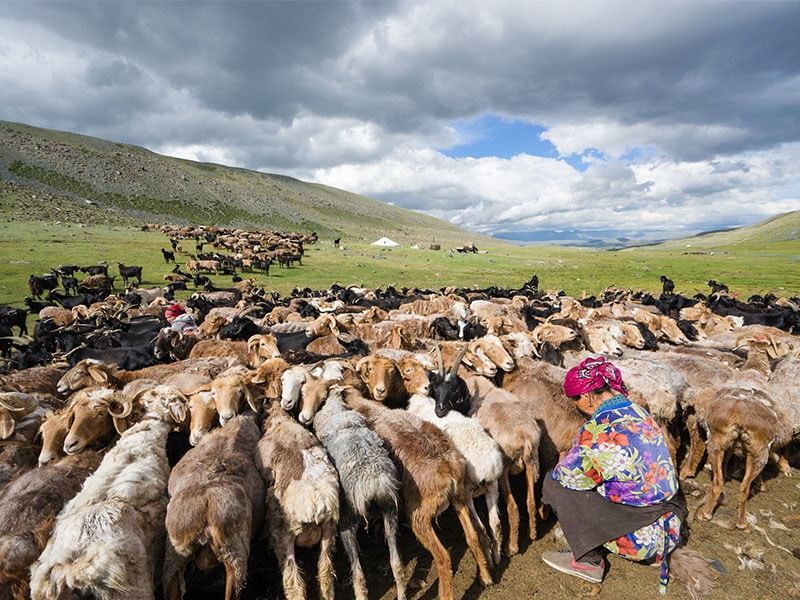We love catching up on the remarkable adventures of Singapore-based non-profit organisation Women on a Mission (WOAM). Here, CHRISTINE AMOUR-LEVAR recounts the group’s recent trip to Mongolia.
Across the wide-open steppe, a lone Kazakh rider galloped towards us on an ebony-coloured Mongolian stallion, a seven-kilogram golden eagle perched on his arm. We watched transfixed as he approached, dressed in his traditional fox-fur cloak and hat with embroidered trousers, just as his ancestors must have looked some 2,000 years ago. Finally, he halted in front of us; then, smiling proudly, he greeted us warmly in the Kazakh language.

It had taken our all-female team two full days to reach this extreme western part of Mongolia from the capital Ulan Bator (or “UB” as it is also known to locals). The Altai Mountains, home of the famed eagle hunters of Mongolia, is a UNESCO World Heritage Site located close to the border of Russia and Kazakhstan. Altai means “gold mountain” and the range is the largest and highest in the country, with towering mountains, glaciers, deep lush valleys and beautiful lakes.
Heavy snow and strong winds had resulted in significant delays to our itinerary, so when we finally arrived – after many hours driving off-road, speeding across rocky trails and snow – and saw such an extraordinary rider appear before us, it only contributed to the feeling that this was one of the most remote places on earth.

Local insights
The Kazakh eagle hunters of this region are a nomadic people spread throughout not just Kazakhstan but patches of Central Asia. For thousands of years, they’ve lived a life based around herding five types of animals: goats, yaks, sheep, Bactrian camels and horses; and they have hunted with golden eagles. Still untouched by mass tourism and deeply steeped in their cultural roots and traditions, the locals have trained their eagles to hunt for food and fur – essential elements in their survival. The birds live until 25 years or so; when they’re around 12, they are repatriated to the wild, in order to breed and provide another generation of hunting birds.

The first few nights of our journey, we were privileged to be hosted in our eagle hunter’s own family home. Bekhbolat, as he is called, lives with his parents, his wife Mariya, and their three children. Upon entering the nomads’ home, we felt immediately welcome as they shared their way of life and their provisions. During our stay, our team slept in traditional ger houses – incredibly comfortable round-shaped tents covered with skins or felt that have a structure comprising an assembly of wooden lattices for walls, a door frame and a crown of compressed rings for the roof.
Chatting over hot tea, vodka, sweet clotted cheese and dried hard curds of yoghurt, we learnt a lot about the family’s life and their concerns for the future. We discovered that 30 percent of Mongolians still live a nomadic life, but the number is falling as the city-dwelling population increases. In truth, these resilient people are the remnants of a disappearing culture that has survived for ages, mostly in harsh, isolated conditions. The Mongolian climate is so extreme and often unpredictable, with winter storms, droughts and desertification all threatening their existence and affecting their livelihood. Lately, summer droughts have resulted in animals not gaining sufficient weight to withstand the ferocity of the freezing winters. Herding life is tough and it seems winters have been even tougher than normal in the last decade.

Changing times
“Mongolian nomads have to adapt or die,” shared Nurka, our Kazakh guide. “For generations, their lifestyle survived, protected by their isolation. But with improved transport and technology, things are changing very fast. The ancient traditional lifestyle has been impacted by mobile phones, motorcycles and iPads, mostly in a positive way – though sometimes I wonder if it’s really for the best.” Nowadays, riding out to herd animals in Mongolia is often done on motorbikes instead of horses; during our journey across the Tavan Bogd National Park, we came across such herders. Even the renowned shaman, Naraa, whom we consulted at our campsite one day, came riding across the plains on a gigantic motorbike.
Meeting the shaman was certainly a trip highlight. She spoke to each of us privately, answering our many questions and appeasing our doubts. In the end, she inspired each one of us in a powerful way, asking us to meet her once again at dawn before we packed up camp, so we could soak up more strength and energy from the sun’s morning rays.

Shamanism is an ethnic religion that has been practised in Mongolia and its surrounding areas since the age of recorded history. During last century’s Soviet years, it was heavily repressed, but it has since made a comeback. In reality, the nomads have adapted to all these changes and so much more. Yet the speed of 21st-century progress is challenging their adaptability to the extreme. While it may actually make their lives easier in some ways, with solar power generators and motorbikes, many nomads have moved into settlements in provincial towns and many more have relocated near the capital, where they have become semi-settled, neither here nor there. Those who move often struggle to make a living, since the towns are lacking in easy, secure work for people lacking skills that don’t involve milking or shearing. As a result, UB and other towns in Mongolia are surrounded by ger encampments.

Journeying on
After a few days with the eagle hunter’s family, our team set off deeper into the mountains to discover the region. Western Mongolia is still relatively unexplored and we came across no other tourists during our time there. The journey took us close to the 20km long Potanin Glacier, the largest and most imposing of 20 glaciers in the Altai range. We continued on to the Khuitas Valley, where we successfully summited two iconic peaks over 3,300 metres high in the surrounding area. Soaking in the profound silence, stunning views and vastness of the Altai Mountains from those summits was all the reward we could have asked for after the long hours of climbing.
Our trekking was punctuated by days of riding on horses across the huge open plains. When not on the trail with us, the animals would roam free. Their normal life throughout the year includes grazing on natural pastures and living within a herd. Facing harsh, cold winters and fending off predators is also part of their daily lives. Since they’re used to moving in herds, as soon as one of us would shout “Chu! Chu!” suddenly all the horses would start trotting and soon break into a gallop, flying across the steppe. The herders would howl with laughter, while some of us would be hanging on for dear life.

The horseback riding was just phenomenal. Some days we would meander along rocky ridges, passing herders and their flocks along the way, other days we would traverse pristine streams and rivers, taking in the wide blue skies, open spaces, snowy mountains and untouched lakes. On occasion, we would come across ancient petroglyph carvings, which illustrate the development of Mongolian culture over a period of 12,000 years. The earliest images reflect a time when the area was partly forested and the valley provided a habitat for hunters of large game. Later images show the transition to herding and a horse dependent nomadic lifestyle – a real archaeologist’s dream and a fascinating catalogue of the evolution of life in the region.
Over a period of eight days, we traversed 900km of terrain on foot, on horseback and in incredibly sturdy – and seemingly unbreakable – Russian minivans, dating to the 1960s. Often, the Mongolian wind would blow unbelievably hard, reaching up to 90km/h, and almost flattening our tents. The team also experienced hugely varying temperatures – anywhere from a bone-chilling minus 17 degrees Celsius to glorious spring days of 24 degrees.

Future hopes
Back in Ölgii, capital of the Altai region, we met Aisholpan Nurgaiv, who became famous in Mongolia and beyond as the star of the 2016 documentary The Eagle Huntress. The film shows 13-year-old Aisholpan, a herder’s daughter, succeeding in the male-dominated world of hunting with eagles in the Altai Mountains. Now 17, the country’s first female eagle hunter has done an enormous amount to help to break down gender stereotypes and shift the attitudes of Mongolia’s dominant ethnic group toward the country’s Kazakh Muslim minority, of which she is a part.
As we feasted on traditional Mongolian meat dishes in a local tavern, serenaded by musicians playing the dombra – a long-necked lute with two strings – Aisholpan shared with us her hopes of finding a way to improve the condition of the Kazakh people in her community, demonstrating a poise and maturity far beyond her years.

In the end, this voyage to the Altai Mountains of Mongolia was a genuinely spiritual and enriching experience – not just for the breathtaking beauty of the places we discovered and the kindness of the local people we met, but also because of our overall mission. Ultimately, our team embarked on this adventure to raise awareness and funds for women who are less fortunate than us. By trekking in such a remote region, we hope to inspire more women to leave their comfort zones, families and homes for a time, while pushing their limits to rally support for a worthy cause. The journey was truly a once-in-a-lifetime experience to the land of the proud eagle hunters, who inspired us with their spirit and resilience, and who were, without a doubt, the wind beneath our wings.

Now in its seventh year of operation, Women on a Mission (WOAM) raises money in support of organisations that advance the position of women and girls around the world. Past expeditions have included Everest Base Camp, the Wadi Rum Desert in Jordan, the Tsum Valley in Nepal, the Yamal Peninsula of Siberia, and the Lut Desert of Iran.
Like this? Read more in our Travel section.
Where to stay and play in Cambodia
Experience a luxury Australian safari
Top spots to make the most of Indonesia
This article first appeared in the November 2018 edition of Expat Living. You can purchase a copy or subscribe so you never miss an issue!





